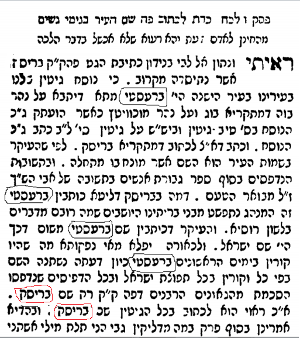The Jews originally used the name Bresti.
 |
| Bresti written in Hebrew, Rashi Font |
This is clear from the Responsa by Rabbi Yaacov Meir Padua, printed 1854 in Warsaw, ruling 28 on pages 51-52. The first paragraph:
 |
The first paragraph of Rabbi Padua's Responsa
Marked in red: Brisk • Marked in black: Bresti |
The Responsa was a collection of questions posed to the Rabbi during his career and the answers he gave. However, in this particular case the answer was not explicitly directed to any person’s question. The Rabbi states in the beginning of the “answer”:
 |
| Rabbi Padua's introduction |
Translation to English:
I decided to examine this issue with regard to the drawing of a gett in our Brisk that has recently been founded [i.e. the new city].
This analysis, therefore, probably dates to not much later than 1837 when the fortress was erected and the old city was replaced by a new city in an area to the east.
Anticipating problems differentiating the new city from the old one, Rabbi Padua states the question:
What place name should we write in a gett [divorce certificate] issued in Brisk?
This is a vital point: A gett may be invalidated by as little as a mis-statement of the geographic location. In Chapter Gitin of the Talmud the rule says: When there are two cities of similar name, specify another nearby geographic feature [e.g. a river or springs] in order to avoid mistaken identity.
Accordingly –partly in Aramaic, in a Talmudic style– R’ Meir Padua writes:
The wording in a gett drawn in our old city was:
Bresti that is located on the river Buh called Bug and on River Muchovitz
The same wording is also found in
Tiv Gittin [1819, by Rabbi Ephrayim Zalman Margaliot, 1760-1828] and in
Yam Shel Shlomo (#32) [1812, by Rabbi Shlomo Luria] without the addition
that is called Brisk. The most important factor:the name of the city as it was in the beginning.
Shabtai Katz’s father, Rabbi Meir Cohen, [in
Gvurat Anashim] explained why the words issued in Bresti were drawn up when the
gett was written drawn in Brisk D’Lita : This custom has spread because most of the Jews who dwelled in Brisk D’Lita spoke Russian [and were influenced by the pronunciation of the name]. Since the Jews used the name Bresti, this was the name that was inserted in the
gett.
On the face of it, what did it matter that they used to call the [old] city Bresti in ancient times? This name has been changed since, and Jews in our city [the old one] and all over the diaspora call our [old] city Brisk. Even in all the printed Haskamot of the gaons and rabbis of our community, only the name Brisk is used. The answer is: even though all Jews started calling the [old] city Brisk, it was ruled that it was still necessary to include the original name, Bresti, in the gett.
Should the new city have the same or a different name?
Now, after the old city has been demolished by the order of the government and its inhabitants moved to establish the town completely outside the Tkhum Shabbat of the old city, should write in getts only Brisk? Now it is a new city, built anew, and not given the name Bresti by the Jews.
Even though he thought that it was enough to write Brisk, the sages decided that the name Bresti would also appear on the gett and the resulting text would appear: in Brisk that was called Bresti that is on the rivers Bug and Muchavetz.
We can clearly see that this legal issue was considered vital, as a person depending on an invalid gett could be severely damaged. In a discussion of an important legal point, we have discovered what the Jews called their ancient city.
| Notes: Responsa: a book composed of question and answers. gett: the more common spelling is get, but we use this variant to avoid confusion. recently established Brisk: In the 1830's the city of Brisk was moved from its original location to make way for the Brest Fortress. Haskamot: Formal, very respectful approvals/endorsements of religious book issue by prominent rabbi-scholars. Tkhum Shabbat: the town enclosure, within which certain physical activities are allowed to observant Jews on the Sabbath. (More, here). |




